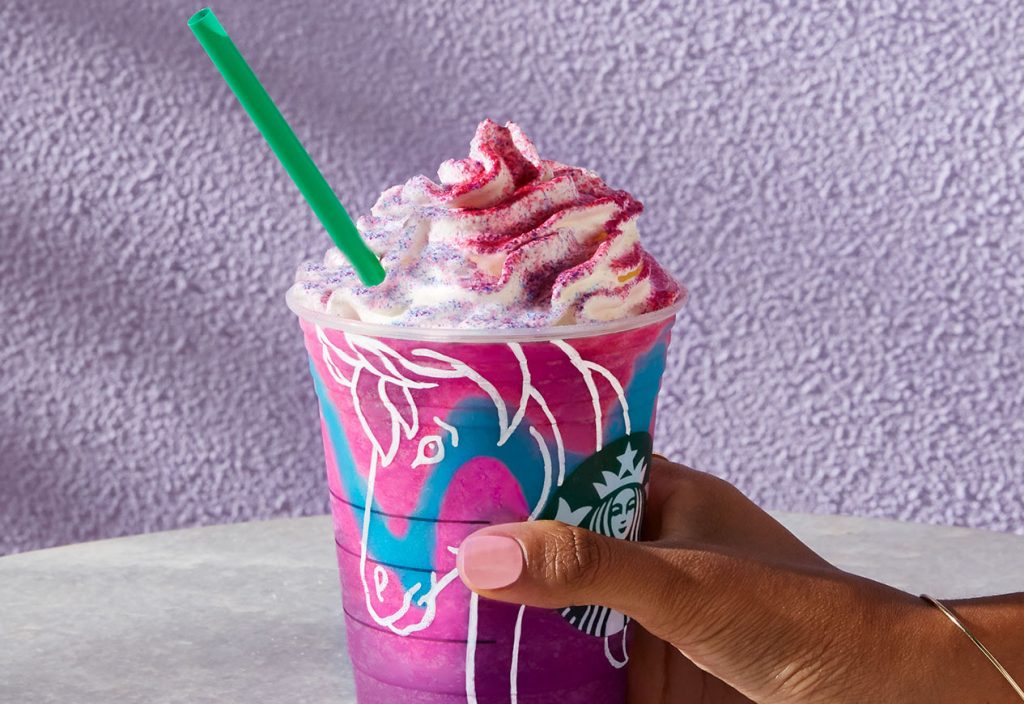
The “Unicorn Frappucino” is dead
Rainbows, glitter, bubbles and some pretty pissed off baristas – Starbucks' five-day unicorn extravaganza has come to an end. Apparently they didn’t even taste that nice – so why was the internet so obsessed?
What’s a Unicorn Frappuccino? Just in case you haven't seen one pop up on your news feed (or you have, and were just baffled) this is how Starbucks described it: “Like its mythical namesake, the Unicorn Frappuccino blended crème comes with a bit of magic, starting as a purple beverage with swirls of blue and a first taste that is sweet and fruity,” said Starbucks. "But give it a stir and its color changes to pink, and the flavor evolves to tangy and tart.”
Tangy and tart doesn’t sound so bad, right? Wrong, according to lots of people – a writer from the Washington Post said it tasted like sour birthday cake and shame. Late Show presenter Stephen Colbert took it one step further. “Oh. I wish I was dead,” he said after, like, one sip. “It tastes like I French-kissed Tinkerbell."
So how does something that is probably not even that nice become so popular? Behavioral economics (and some savvy marketing skills.)
The Instagram thing
Starbucks knows that people buy into brands for a lot more complex reasons than just needing the product they sell. This all singing, all dancing, color-changing, magic-frap was 100% for the eyes (and the gramz), not the taste buds / energy levels. At the time of writing there were over 150,000 posts on Insta with #unicornfrappuccino.
The unicorn trend has been around a while on social media (remember rainbow bagels?). It’s got it all – a little bit of FOMO ("why is she eating a rainbow bagel while I’m eating a store-bought sandwich at my desk"), a lot of visual-impact (it changes COLOR for chrissake), and is pretty easy to get a piece of – you just have to get to a Starbucks (Mr Starbucks thinks: kerching).
Social media has been an absolute gift to marketers. There’s a theory called herd instinct in (sorry) which says that humans are basically just sheep, and follow along with a pack. If everyone else is doing something, we wonder why they’re doing it and probably start doing it too.
Social media, particularly something visual like Instagram just speeds up that process. If we see people on our feeds doing something or getting in on a trend, we’re probably pretty likely to want to do it too.
The five days only thing
THIS-IS-THE-OLDEST-TRICK-IN-THE-BOOK. For years, marketers have been playing around with the pretty basic economic theories of 'supply and demand' and 'scarcity' (economists argue that the balance between how much of a product is actually available – or the supply – and how many people want it – the demand – has an impact on how much of that product is produced and how much it will cost).
But in marketing, people have found that making a product scarce (or limiting the supply) also increases demand. This is a principal brands use all the time. Think about limited-time offers ("you have to buy this half-price hat now"), or think about how much everyone freaks out when McDonald’s brings out the McRib every now and again. Making food products, or deals, or any other popular product, not available all the time suddenly elevates it from just a tasty rib (or coffee-less iced coffee) to having some kind of cult status. Like a mythical creature – or a unicorn.
So the five days are up. No more unicorns?
Thhere's nothing to say that the success of the unicorn frapp might mean Starbucks follows McDonald’s lead and brings it back every now and again to whip up a bit more hysteria. Though the brand itself has stayed pretty schtum about the whole thing, other than pointing out that it brings out seasonal special drinks all the time. There are always copycat versions – recipes for how to make your own multi-colored cream are already cropping up everywhere, for example – and other brands are still trying to push their own 'unicorn' products.
But you can’t help but wonder if enough is enough on the whole unicorn thing. How much more pink cream can we take? Besides, the internet has a pretty short attention span – we'll be freaking out about something else pretty soon (as long as everyone else is too.)



